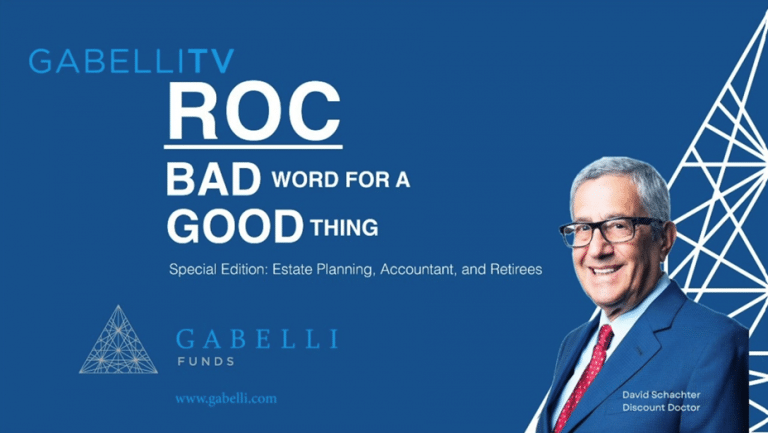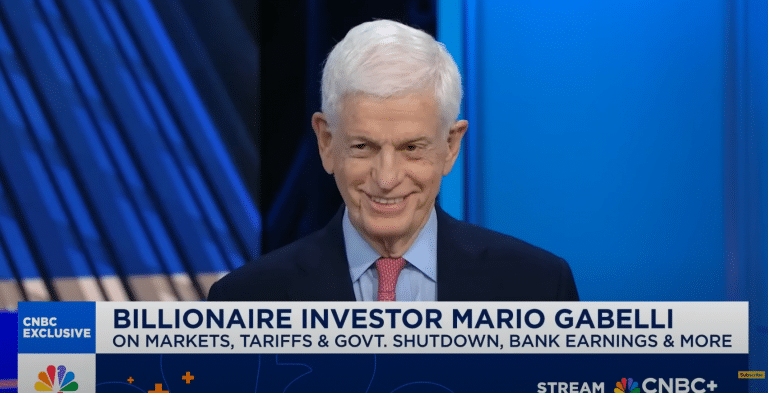Gabelli Funds and Columbia Business School co-hosted the 7th Annual Healthcare Symposium on November 14, 2025. The symposium addressed the future of multi-cancer screening, empowering beneficiaries through consumerism, developments in aging in place, and vaccine access and development. The panelists consisted of senior executives from both public and private healthcare companies, as well as academics from leading institutions.
Opening Remarks
Global healthcare spending is rising faster than global GDP, driven by demographic changes, medical innovation, and persistent inflation. In the United States, population aging is a key factor: as of 2024, approximately 62 million Americans, or nearly 18.6% of the population, are 65 or older and entering their highest years for healthcare demand. Within this group, more than 17.7 million are aged 75 – 84, and over 7.1 million are 85 and above. Europe shows similar trends with increased demographic pressures, while many emerging markets – especially in East Asia (namely China), Latin America, and Eastern Europe – are experiencing even more rapid population aging linked to falling birth rates.
Exhibit 1 Aging U.S. Population
Healthcare Spending Growing Faster than GDP: In the United States, healthcare expenditures reached approximately $5.3 trillion in 2024, accounting for 18.0% of GDP, up from 17.6% the prior year, according to the latest CMS estimates. Projections show healthcare’s share of the economy will continue to climb, reaching over 20% of GDP by 2033 as annual spending growth outpaces GDP gains. Across Europe, total healthcare spending surpassed €1.7 trillion in 2023, representing roughly 10.0 – 10.9% of GDP depending on which country, with top spenders like Germany and France nearing 12%. European health systems remain under sustained financial pressure, grappling with aging populations and system capacity constraints. Emerging economies, starting from lower per-capita spend bases, continue to see double-digit increases in healthcare expenditure, propelled by rising incomes and rapidly growing demand for higher quality care.
GLP-1’s: One of the most significant trends impacting the market over the last several years has been the development of a new class of medicine known as GLP-1’s for both Type II diabetes and obesity. It is expected to become the largest drug class ever with over $100 billion a year in annual sales. The drugs have remarkable benefits on cardiovascular health, kidney disease, sleep apnea, and many other areas as well. In the United States, these drugs, along with an improved diet and exercise appear to have finally halted and even reversed the obesity epidemic in this country.
From a market access perspective, Eli Lilly’s and Novo Nordisk’s recent agreement with the Trump administration marks a notable step toward expanding consumer reach. Under this arrangement, GLP-1’s will be included in Medicare and Medicaid coverage for obesity, not just obesity-related comorbidities, which will unlock access for nearly 40 million individuals who previously had limited coverage. Both Eli Lilly and Novo Nordisk also received priority review vouchers, expediting regulatory timelines for their respective oral GLP-1 drugs. This will likely shorten the FDA approval process from the typical 10 months to just 1-2 months, resulting in anticipated broad market availability for GLP-1 pills as early as 2026.
Exhibit 2 Healthcare Spending as a % of GDP
Source: CMS
Drug Price Negotiation: 2026 marks the first year of drug price negotiations under the Inflation Reduction Act. The initial group of 10 drugs covered under Medicare Part D is expected to see an average net price reduction of around 22% for seniors, generating approximately $6 billion in savings – a figure the industry can withstand. However, the program is set to broaden substantially in the coming years, eventually encompassing Medicare Part B drugs. How aggressively the new Trump administration will pursue additional discounts from manufacturers remains uncertain. The negotiated price reductions for the next 15 drugs, which will take effect in 2027, are anticipated to be released by the end of November 2025.
Mergers and Acquisitions: In contrast to the Biden administration’s stringent scrutiny of healthcare transactions, the Trump administration has adopted a lighter regulatory approach, which has facilitated a notable surge in dealmaking activity in 2025. The healthcare sector has seen a wave of large biotech acquisitions this year, including deals of roughly $10 billion or more involving Intra-Cellular Therapies (ITCI – NASDAQ), Blueprint Medicines (BPMC – NASDAQ), Verona Pharma (VRNA – NASDAQ), Avidity Biosciences (RNA – NASDAQ), and Metsera (MTSR – NASDAQ). Despite this robust M&A environment, large pharmaceutical companies continue to face approximately $200 billion in patent expirations over the next five years, suggesting that deal activity is expected to persist as companies seek to bolster their pipelines and revenue streams.
Panel 1 The Future of Multi-Cancer Screening
Carri Chan, PhD, Professor, Columbia Business School – Moderator
Panelists:
Quest Diagnostics (DGX – NYSE) – Asia Chang, VP & General Manager, Oncology: Asia is the VP and General Manager of the oncology franchise at Quest Diagnostics, where he leads the business responsible for cancer testing across the cancer care continuum from screening to post-treatment monitoring.
Exact Sciences (EXAS – NASDAQ) – David Harding, SVP of Pipeline Product Management: Prior to his current role, David served as SVP, Multi-Cancer Early Detection where he focused on diligence and integration of acquired businesses and market access for product lines in the U.S.
Guardant Health (GH – NASDAQ) – Noam Krantz (CBS ’01), SVP, Corporate Development: Noam oversees the company’s mergers and acquisitions, licensing, and investment strategies, in addition to the long-range planning for the organization.
Grail (GRAL – NASDAQ) – Alexis Tosti (CBS ’01), SVP, Strategy & Corporate Development: Alexis oversees corporate development and investor relations activities at GRAIL.
Takeaways:
- Market Landscape and Systemic Drivers: Aging demographics, U.S. healthcare spending (>18% of GDP today, heading toward 20% by early 2030s), and a rising global cancer burden (projected 35 million cases and 18.5 million deaths by 2050) are setting increased demand for scalable, efficient early cancer detection technologies. Cancer is increasingly considered a chronic disease requiring ongoing management, not merely episodic treatment. Advances in multi-cancer early detection (MCED) can shift both cost and care curves by enabling earlier, more curative interventions. The U.S. payer system places diagnostics far downstream in the value chain, with only 10% of value assigned to early detection; the remainder is spent on surgery and expensive therapies, representing a market inefficiency.
Approaches to Multi-Cancer Early Detection (current state by company):
- Exact Sciences (EXAS – NASDAQ): Cologuard has screened 20 million individuals for colorectal cancer and is now advancing Cancerguard, its own multi-cancer early detection (MCED) test. The brand is recognized for its strong presence with consumers and primary care providers. The planned MCED is designed to complement standard-of-care direct organ screens, offering blood testing for cancers in organs that are less accessible to traditional screening. A major opportunity lies in integrating data across five million modeled patients aged 50 – 84, where annual MCED plus standard-of-care screening could reduce stage 4 cancer incidence by more than 40% and decrease overall cancer mortality by 18%, compared to a 2% reduction seen with new therapies alone. Early-stage (stage 1/2) cancer detection is estimated to be four-to-seven times less costly than treating advanced-stage cancers. On the other hand, challenges include product confusion among providers, adherence to multiple annual tests, and the risk of MCED adoption cannibalizing existing standard-of-care testing. Following the conclusion of the conference, Exact Sciences announced its acquisition by Abbott for $105 per share in cash ($21 billion), highlighting the strong market enthusiasm for innovation in early cancer detection.
- Grail (GRAL – NASDAQ): The Galleri test can detect up to 50 cancers using a shared blood signal. Key advantages include broad cancer coverage, a single testing approach, & significant potential for population health impact. However, widespread adoption will require substantial education, as the current market remains oriented toward single-indication screening & must evolve to support a multi-cancer paradigm.
Exhibit 3 Global Cancer Burden
Source: International Agency for Research on Cancer
- Guardant Health (GH – NASDAQ): Guardant Shield originated as a colorectal cancer screening test and is now expanding into multi-cancer early detection (MCED) through real-world data collection and participation in NCI Vanguard studies. Notably, 90% of Shield users were never previously screened, doubling screening rates in select healthcare institutions. This creates opportunities to build real-world biobanks of over one million patients and to broaden cancer testing to include lung and other cancers, positioning Shield as one of the fastest-growing diagnostic launches outside the COVID period. However, achieving access, reimbursement, and impact for each cancer type requires indication-by-indication progress to address unique coverage and prevalence challenges.
- Quest Diagnostics (DGX – NYSE): Quest Diagnostics delivers diagnostic access at an unprecedented scale, with more than 650,000 clinicians, 6,000 in-office phlebotomists, 2,000 service centers, and a rapid courier network across the country. The company partners with nearly all major diagnostic MCED developers and is advancing its own MD Anderson–based protein biomarker risk test to enable longitudinal, programmatic screening and risk stratification beyond traditional age and gender measures. Quest’s unique infrastructure supports seamless patient and provider logistics, integration with electronic health records (including an Epic partnership), and population-level data collection. Challenges include navigating perceived channel conflicts, ensuring access and evidence generation for reimbursement, and supporting adherence and triage pathways after screening
- Partnerships, Infrastructure and Access: Deep, multi-pronged partnerships are essential, with Quest serving as the collection infrastructure backbone, health systems facilitating integration, pharma providing follow-up therapies, payers supporting reimbursement, and government driving policy change. Guardant has conducted 20-40 pilot programs and collaborates actively across these stakeholder groups. Quest’s nationwide reach expedites evidence generation and broadens access, a priority consistently cited by all panelists. Nevertheless, diagnostic companies must successfully navigate high test development costs, complex approval pathways, a fragmented market landscape, and the ongoing necessity to demonstrate incremental value to payers.
- Economics, Policy, and Reimbursement: Reimbursement remains the primary challenge to widespread MCED adoption, with evidence generation for CMS and payer coverage progressing slowly and requiring large-scale studies. All companies are actively advocating for Medicare legislation to support MCED, seeking to advance coverage at the federal level. Currently, diagnostics are undervalued within the cost-plus reimbursement framework, and public policy must evolve to better recognize and appropriately value earlier test information.
- Outcomes and Evidence: Health economic models consistently show that early cancer detection is far more cost-effective than treating advanced-stage disease; treating Stage 1 or 2 cancers is four-to-seven times less expensive while providing significantly better outcomes. When population-wide MCED testing is added to current standard-of-care screening, models project dramatic reductions in both mortality and late-stage incidence, including a greater than 40% decline in Stage 4 cases and an 18% reduction in overall cancer mortality over a decade.
- Current Challenges: Current challenges in the industry include establishing reliable clinical sensitivity and specificity for MCEDs in low-prevalence, asymptomatic populations. Achieving a high negative predictive value requires serial (annual) testing, which raises payer concerns about lifetime cost implications, though the cumulative life years gained typically justify the investment. Engagement from both providers and public health agencies is needed, as population-level health improvement demands surveillance and dynamic risk assessment that go beyond current age and gender screening benchmarks. Technical obstacles persist around pre-malignant and blood-based early detection for several cancers, but rapid progress is expected in overcoming these issues.
- Future Outlook: MCEDs and risk markers are poised to become central to chronic risk management, with broad integration into public health programs, regular screening protocols, and personalized triage. Partnerships with pharmaceutical companies are underway to explore preventive and chemo preventive interventions. AI-driven analysis of biobank data, including Guardant’s dataset of over one million patients, and potentially scaling to hundreds of millions, is expected to yield novel risk markers and new intervention approaches. The long-term vision is to shift cancer from an episodic diagnosis to a model of managed, longitudinal risk similar to cardiometabolic frameworks, such as regular A1c testing for diabetes. Ultimately, the combination of expanded access, dynamic risk stratification, and robust payer and policy engagement is expected to redefine cancer care economics and treatment efficacy for decades.
Panel 2 Empowering Beneficiaries Through Consumerism
Daniel Barasa, Portfolio Manager, Gabelli Funds – Moderator
Panelists:
HealthEquity (HQY – NASDAQ) – Brad Bennion, EVP Strategy / Corporate Development: Brad leads the company’s strategic planning process by improving core organization capabilities as well as identifying new markets and channels.
WEX (WEX – NYSE) – Chris Byrd, SVP, Health and Benefits: Chris was a co-founder of the business and has played a variety of leadership roles in guiding the company to its current breadth and scale. He is currently responsible for strategy, mergers and acquisitions, strategic partnerships, and government relations.
Aetna (CVS – NYSE) – Jill Dailey, VP, Head of Commercial Product: Jill and her team design and manage high-quality, cost-effective solutions and critical strategies to drive member engagement.
Oscar Health (OSCR – NYSE) – Jesse Horowitz, Chief Product Officer: Jesse is responsible for the development of Oscar’s product strategy and roadmap, focused on building technology and experiences that create differentiated applications and capabilities.
Takeaways:
- US Healthcare Spending: Despite two decades of focus, U.S. health care spending is nearing 20% of GDP, and consumer-driven models have not delivered broad spending reductions. There has been progress in select markets such as LASIK, GLP-1 use for weight-loss/diabetes, and virtual musculoskeletal physical therapy – demonstrating that when consumers have access to clear, timely information, and direct financial incentives (e.g., HSAs), more rational spending decisions do occur. There is a great opportunity for broader HSA adoption, deploying consumer-facing tools, and enabling actionable transparency to give individuals the motivation and capacity to influence costs.
- The healthcare system faces several structural challenges: The system remains highly complex, with unpredictable costs and weak out-of-pocket estimation tools, even where nominal price transparency exists. Legacy employer-based benefit designs limit consumer choice, as many employers offer only a few undifferentiated, national-network plans, even in high-deductible formats. Insurers and PBMs keep critical data in silos, and while much of it is machine-readable, it is presented in ways that are unusable for consumers, undermining true comparison shopping. Trust in insurer guidance is low, and even when AI-driven “smart matching” tools are available, many consumers still rely more on peers than on plan recommendations, blunting the impact of digital navigation solutions.
- Federal Policy and Price Transparency: Recent federal rules – such as hospital price transparency requirements, surprise billing protections, and Most Favored Nation drug pricing initiatives – have begun to dismantle long-standing data barriers in healthcare. Nonetheless, meaningful price comparison tools are still limited due to continued data silos and the influence of physicians’ prescribing and referral patterns (“power of the pen”). Increasingly, drug pricing is being approached as a matter of international trade, with U.S. patients effectively subsidizing global R&D. As a result, government policy is shifting its focus toward aligning prices internationally, rather than only domestically. The largest remaining challenge and opportunity is converting available data into actionable, user-friendly intelligence that empowers consumer decision-making.
Exhibit 4 Rise in Deductibles Among Covered Employees
Source: KFF
- Insurance Plan Design and Incentives: High-Deductible Health Plans (HDHPs) were designed to give consumers more financial responsibility in their healthcare decisions, theoretically encouraging thoughtful use of resources. While these plans can reduce unnecessary utilization, they often increase out-of-pocket costs for households and are commonly associated with frustration, confusion, and restricted product choices. The industry is testing new behavioral strategies – such as tiered emergency room cost-sharing, where the first two visits are free and subsequent visits incur significant charges unless they are for legitimate emergencies – to promote deliberate decision-making at the point of care. These tools are being piloted to encourage more conscious consumption, especially in acute settings.
- Several challenges remain: The healthcare system’s one-size-fits-all model remains dominant, leaving people with specialized health needs or geographic constraints underserved. While ACA reforms have improved coverage financing, they have not fundamentally altered cost structures or aligned incentives across the industry. However, the growing adoption of Individual Coverage Health Reimbursement Arrangements (ICHRAs), where employers deposit funds for employees to purchase their own insurance products – often 20-30% less expensive than typical group plans – could expand consumer choice, flexibility, and competition.
- Artificial Intelligence (AI) & Technology: Oscar Health uses gamification, chatbots, personalized digital nudges, and integrated virtual urgent care to drive member engagement. Aetna utilizes AI-based provider matching that incorporates member language preferences, history, and user profiles, adding explainability features to build trust. WEX and HealthEquity emphasize AI tools for benefits selection and HSA optimization – users increased HSA contributions by an average of 25% after using these digital tools – and are rolling out “Agentic AI,” which acts as an intelligent digital concierge to help with plan navigation, contribution decisions, and healthcare shopping. The rapid adoption of generative and agentic AI is generating immediate improvements in claims processing, self-service support, and personalized plan recommendations. Nonetheless, human support is still essential for complex or high-risk decisions, and challenges remain around AI explainability and ensuring reliable data sourcing, particularly for digital health and medical advice.
Exhibit 5 Health Savings Accounts Assets by Age Group
Source: Devenir
- HSAs, Consumer Behavior, and Investment trends: Nationally, only about 10% of HSA holders invest their balances – despite 60% indicating they intend to use HSAs for retirement savings. The main barriers are financial: most participants keep 2.5–3.0x their deductible in cash for security, resulting in $55 billion deposited yearly and $42 billion spent directly on healthcare needs. Providers like WEX and HealthEquity earn slightly higher margins on cash balances than on investments but promote investing for consumer benefit; higher investment and deferred utilization are linked to better long-term outcomes and industry-wide cost pressures. Expanded HSA eligibility, now including many Bronze plans, is a step forward, but universal access is needed for system-wide impact.
- Specialty Drugs and Site of Care: Medical benefit design increasingly relies on strategies like formulary adjustments – for example, Aetna moved 95% of Humira patients to biosimilars in one month, four times the industry rate – along with specialized network curation for gene therapy administration and “site-of-care” steering for complex drugs such as KEYTRUDA, where shifting infusions outside the hospital yields significant savings. Key hurdles remain in patient education, logistical execution (ensuring the right provider, site, and dosage), and prior-authorization requirements. The growing complexity of new specialty and biologic drug launches presents ongoing challenges but also substantial opportunities for technology-enabled navigation, care coordination, and enhanced patient-provider engagement models.
- Preventative Care and Longevity: Preventive interventions and wellness now comprise a $500 billion market (4-5% annual growth), with individuals under 35 engaging at higher rates than the general population. Payers and employers are leading innovation by introducing financial incentives for preventive service use, telehealth adoption, mail-order pharmacy programs, and addressing targeted care gaps. For ongoing growth and sustainability, it will be crucial to align incentives with longer plan tenure, maximize digital interactions, and redesign benefit structures to foster long-term engagement and retention.
- Challenges: High-value primary care can generate meaningful savings – typically several hundred dollars per member per year for primary care physicians and about $1,000 annually for orthopedic care. However, real-world data linking total costs and outcomes after health plan selection remain limited, as most measurement frameworks still focus on disease management rather than member engagement. Short average health plan tenures (around 18-20 months) further discourage payers from funding long-term preventive initiatives. Meanwhile, employers and HR leaders face growing fatigue from the proliferation of narrowly focused point solutions with low adoption and limited ROI, driving consolidation and the bundling of offerings across the industry.
- Digital Therapeutics, Virtual Care, and Wearables: Oscar Health has offered integrated virtual urgent care since 2014, but both awareness and engagement among members remain limited. Meanwhile, Aetna /CVS Health is piloting “AI-first provider rates” in three states – Florida, Texas, and Colorado – to evaluate how AI-driven digital triage tools impact clinical outcomes, particularly in areas such as FDA-cleared digital therapeutics and efforts to divert ER visits.
Panel 3 Developments for Aging in Place
Rebecca Stern, PhD, Analyst at Gabelli Funds – Moderator
Panelists:
InnovAge (INNV – NASDAQ) – Ben Adams (CBS ’94), CFO: Ben brings nearly three decades of healthcare finance experience to InnovAge, including most recently as the CFO of Kepro, a physician-led company that facilitates care for priority populations and helps them remain in the home or community of their choice.
SCAN – Joe Kimura, MD, MPH, Chief Medical Officer: Joe is the Chief Medical Officer of SCAN Health plan, where he guides the development and implementation of the organization’s clinical strategy.
Signify Health (CVS – NYSE) – Marcus Lanznar, President: Marcus is a seasoned leader with a strong background in product management and healthcare innovation. Before his current role, he served as SVP of Product at Signify, where he played a key role in developing and scaling the company’s offerings.
DispatchHealth – Pippa Shulman, DO, MPH, Chief Medical Officer: Pippa joined DispatchHealth’s leadership team during the company’s merger with Medically Home, where she served as Chief Medical Officer and Chief Strategy Officer. As the clinical architect behind many of the company’s innovative models, Dr. Shulman helped shape what is now part of DispatchHealth’s approach to high-acuity care in the home.
Takeaways:
- Inefficiencies in the aging-in-place healthcare model: There is enormous complexity associated with getting care into the home or other non-facility care sites, from both logistical and regulatory perspectives. In addition, reimbursement is confusing and Medicare has room for improvement in what services it pays for and for which patients. Identifying precisely what patients need and bridging the gap between the care model and the payment model will be key to success for home-based care companies. Coordination among all stakeholders will be crucial for scaling aging-in-place healthcare programs, particularly with respect to ensuring that discrete services are coordinated efficiently. As the home healthcare market size grows (Exhibit 6) and increased healthcare capabilities move into the home, logistics and supply chain management become central issues.
Exhibit 6 Home Healthcare Market Size (USD Billion)
Source: Towardshealthcare.com
- Role of private capital and public private partnerships: The non-profit sector does a great job, but it is not very good about developing a model and driving it to scale or pushing it out to the broader population. The way to scale up and broaden scope is with private capital; private capital can implement change faster and easier, with fewer barriers to entry from different players in the healthcare system. In addition, volatility in the system with respect to the uncertainty about the future economic model and funding for Medicaid, is a related factor in innovation, even if it is private capital backed.
- Technology and AI for identifying and treating patients in the home: Technology and AI are going to be critical for improving inefficiencies related to matching patients with home-based care services. Technology can help find patients and get them ready, engaged, and better able to take advantage of the resources home-based care models offer. In addition, as the scope and complexity of home-based care grows, technology and AI for coordination and facilitation will help ensure that health needs like oxygen delivery are available. AI can also help reduce the administrative burden on clinical staff – tasks like claims processing and medical records summarizing can be accomplished using technology, so practitioners can reallocate their time to improve patient care and lengthen beneficial patient-caretaker interactions. The positive effect of this will be compounded by an enhanced relationship between the provider and patient, leading to greater trust in patients with their care team. In addition to making the company more efficient and saving costs for the providers, which can be put back into patient care, it can also be directed to broaden services. AI can be used to devise a care plan, sifting through exhaustive medical records, saving clinicians thousands of pages of reading and potentially even human-induced error. Patient outcomes will also improve by helping identify high-complexity patients and move them from Dual-Eligible Special Needs Plans (DSNP) into Program of All-Inclusive Care for the Elderly (PACE), which offers more appropriate reimbursement and a fully capacitated care environment.
- Key Health Priorities for Aging Patients: Many customers or patients do not have the information or ability to identify their needs in the healthcare system or to know the best steps for their healthcare. It is important for companies to make sure patients feel like they can trust who they are engaging with and know what to do next in their care journey. Patients do not necessarily want a lot of remote monitoring; they want to feel like they can get healthcare when they need it. In the times when patients do not need care, they desire autonomy and independence. Patients largely do not want to feel pushed with solutions or monitoring that they do not feel or see a need for. PACE and other similar models are excellent because they bring social intervention in addition to medical care; AI and tech not only help clinicians and companies figure out what to do from a care perspective, but it also helps patients and care plan members equilibrate some of their understanding and education to be more equal partners in the care team. Streamlining care and developing a model where elderly patients feel they can trust their provider helps reduce the burden on them of making multiple discrete service decisions, which increases exponentially as health declines. Finally, patients sense a lot of confusion about payment models and a lot of miscalculations occur that could be ameliorated with better patient education.
- Major Innovations and Shifts in Aging in Place and Payment Models Over the Next Five Years: General optimism was expressed by the panelists about the future of aging-in-place care models. Panelists expect to see more tightly coordinated care, more simplified payment models, and a way to get technology that is assistive in developing care plans and not intrusive in peoples’ lives. The power of AI will help us cut through the coordination of interventions gathering and sorting, and better match patients to appropriate care paths. Technology will help patients feel less lonely and isolated, and it will help clinicians feel less burdened by administrative tasks. Reimbursement for care in the home can be shifted, and hospitals will become more primarily focused on what they do best – high complexity care.
- Health communication and digital media for guiding customers: These services are not necessarily helpful because they push different agendas and information to patients. Patients can get easily confused, which is an obstacle to activation. There needs to be greater alignment in communication to patients and better responsiveness of technology to the wide spectrum of technology literacy.
- What is the target customer for aging in place: When people touch a facility, their functional status declines; it is important to try to keep individuals out of hospitals and focus on preventative care. Keeping them independent, focused on activities and engaging with family and friends is key.
Panel 4 Vaccine Access and Development
Elena Meng, Analyst at Gabelli Funds – Moderator
Panelists:
Merck (MRK – NYSE) – Michelle Kehily, VP, US Leader; Pediatric & Pipeline Vaccines: Michelle leads Merck’s U.S. Pediatric & Pipeline Vaccines business. Since joining Merck through the Schering-Plough integration, she has held senior U.S. and international roles spanning strategy, operations, and P&L leadership, including digital and analytics transformation.
Columbia Mailman School of Public Health – Stephen Morse, PHD: Stephen is a professor of epidemiology at Columbia and a leading authority on emerging infectious diseases, surveillance, and biodefense. He previously served on the National Science Advisory Board for Biosecurity, helped found CDC’s Emerging Infectious Diseases journal and ProMED, and co-directed USAID’s PREDICT program.
AbbVie (ABBV – NYSE) – Michael Paas, VP, Head of Value & Access: Michael heads AbbVie’s Value & Access function, engaging U.S. payers and healthcare decision-makers to support access across the portfolio. He previously led global and U.S. market access and pricing at Regeneron and Bristol Myers Squibb, and earlier built the U.S. consulting practice at GfK Bridgehead
Columbia Irving Medical Center – Magdalena Sobieszcyk, MD, MPH: Dr. Magda Sobieszczyk is Chief of Infectious Diseases at Columbia and a clinical virologist specializing in vaccine and antiviral development. She leads NIH-funded clinical trials in HIV, HCV, COVID-19, and emerging pathogens, with a focus on equitable access to prevention tools
Takeaways:
- Vaccine Confidence & Trusted Messengers: Pediatric vaccine confidence remains resilient, with strong bipartisan support for routine childhood immunizations despite rising polarization. The share of parents strongly opposed to vaccines has roughly doubled over the last five years, yet pediatricians and frontline clinicians continue to be the highest-trust information source. Local pediatricians on TikTok/Instagram increasingly act as influential micro-messengers, counterbalancing misinformation and amplifying adherence to routine schedules.
- Drivers of Hesitancy & Risk Perception: Broader societal anxiety, political fragmentation, and the absence of visible vaccine-preventable diseases (e.g., measles, mumps) reshape parents’ risk-benefit calculus. Vaccines have become “victims of their own success” – younger cohorts have never witnessed the underlying diseases, making marginal perceived risks of vaccination loom larger. This dynamic elevates the burden on clinicians to contextualize disease severity, normalize routine immunization, and proactively re-frame respiratory vaccines (COVID, flu, RSV) as standard annual care.
Exhibit 7
Source: Vaccination Coverage and Exemptions among Kindergartners, Center of Disease Control and Prevention(U.S.)
- Clinical Approach & Community Engagement: Distinguishing legitimate concerns from entrenched anti-vaccine beliefs requires open-ended dialogue, multi-visit trust building, and nonjudgmental communication. Many patients require a multi-month “vaccine journey” before readiness to vaccinate. Clinicians emphasized that community influencers – church leaders, elders, pharmacists, and local digital creators – play a critical complementary role in shifting attitudes and reinforcing pro-vaccination norms within cultural or geographic micro-communities.
- Access, Coverage, and Equity: Pediatric vaccines remain one of the most equitable and well-funded domains in U.S. healthcare. Commercial insurers consistently reimburse ACIP-recommended vaccines and view them as highly cost-effective interventions. For uninsured children, the federal Vaccines for Children (VFC) program ensures broad access with no-cost coverage. However, adult and seasonal vaccine access is more fragile as COVID-era emergency funding expires, raising risks of widening inequities in COVID, RSV, and flu vaccination uptake.
- Value, Evidence Communication, and Payer Alignment: Market access teams must translate clinical evidence into population-level impact for HTAs, payers, and policymakers. Societal benefits – reduced absenteeism, enhanced educational attainment, improved productivity – are critical components; studies show $1 invested in vaccination yields $20-50 in societal ROI. That said, pharma credibility remains a challenge, making clinicians and pharmacists more effective communicators of nuanced value narratives at the point of care.
Exhibit 8
Source: Health Affairs
- Vaccine Development and Platform Innovation: Next-generation platforms – including mRNA, viral vectors, and protein-based technologies – are reshaping vaccine development by enabling faster design cycles, scalable manufacturing, and rapid adaptation to emerging pathogens. The industry is advancing toward multi-pathogen combination programs (flu/COVID/RSV) and expanding into new areas such as oncology, chronic infections, and maternal immunization. Continued progress depends on stable funding for early-stage research, predictable regulatory pathways, and coordinated public-private partnerships to accelerate clinical translation. Challenges include manufacturing bottlenecks, global distribution disparities, and the need for harmonized regulatory standards to support rapid but reliable development timelines.
- System Readiness, Surveillance, and Policy Considerations: Sustainable funding and reimbursement pathways for respiratory and emerging vaccines are increasingly essential as federal pandemic support recedes. Strengthening surveillance infrastructure, ensuring stable adult vaccine financing, and integrating multi-pathogen vaccination (flu/COVID/RSV) into annual preventive care frameworks are key to long-term system resilience. Persistent challenges include reimbursement uncertainty, inconsistent payer coverage, and uneven provider readiness across regions.
191 MASON STREET, GREENWICH, CT 06830 Gabelli Funds TEL (914) 921-5000 Fax 914-921-5098
This whitepaper was prepared by Daniel Barasa, Elena Meng and Dr. Rebecca Stern. The examples cited herein are based on public information and we make no representations regarding their accuracy or usefulness as precedent. The Research Analyst’s views are subject to change at any time based on market and other conditions. The information in this report represent the opinions of the individual Research Analyst’s as of the date hereof and is not intended to be a forecast of future events, a guarantee of future results, or investments advice. The views expressed may differ from other Research Analysts or of the Firm as a whole.
As of September 30, 2025, affiliates of GAMCO Investors, Inc. beneficially owned less than 1% of all companies mentioned.
This whitepaper is not an offer to sell any security nor is it a solicitation of an offer to buy any security.
Investors should consider the investment objectives, risks, sales charges and expense of the fund carefully before investing.
For more information, visit our website at: www.gabelli.com or call: 800-GABELLI
800-422-3554 • 914-921-5000 • Fax 914-921-5098 • info@gabelli.com











